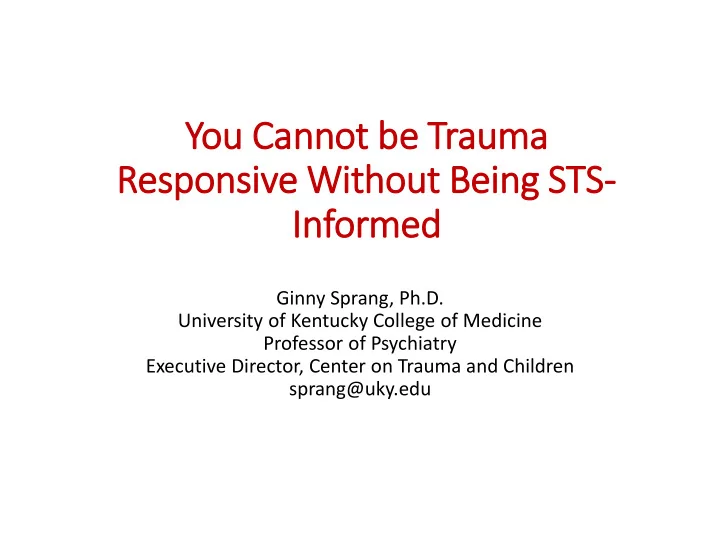

You Cannot be Trauma Responsive Without Being STS- In Informed Ginny Sprang, Ph.D. University of Kentucky College of Medicine Professor of Psychiatry Executive Director, Center on Trauma and Children sprang@uky.edu
BLUF • Work with trauma exposed clients can produce symptoms of distress and even traumatic stress in those who work with them • These symptoms can be prevented and/or managed though individual AND organizational action • TIC provides the pathway for addressing Secondary Traumatic Stress • You can’t be trauma responsive if you aren’t STS informed
Learning Objectives 1. Describe secondary traumatic stress and related conditions 2. Assess the degree to which their workplace is secondary traumatic stress informed 3. Integrate secondary traumatic stress initiatives into their organization’s workforce development plan
The Promise and Challenge of Trauma Informed Care
“… We are stewards not just of those who allow us into their lives but of our own capacity to be helpful...” Jon Conte
Secondary Traumatic Stress is not just a Psychological Phenomenon
Stress Hierarchy Normal Moderate Extreme Stress Stress Stress
Stress Continuum Normal Moderate Extreme Sends the signal to be Activates fight, flight or Immediate action required Amygdala alert freeze to preserve life/integrity Memory retrieval is shut Sorts through memory for Memory retrieval may be down or significantly Hippocampus relevant information to delayed or disorganized impaired. Unable to file inform action new memories Uses this information to Effective problem solving Information processing is Temporal Lobe make a decision and act is severely impaired slowed
Normal Stress at Work Our Body and Brain work together to – Regulate emotion – Process information – Use regulation and information processing to form healthy relationships
Secondary Traumatic Stress – Identifying Options are less accessible – Clear thinking is impaired – We may overreact to situations causing impairment in our relationships – We are not less intelligent, emotionally intelligent or capable, we are trapped in an ALARM state
Secondary Traumatic Stress • A result of the brain’s ALARM doing its job • It occurs because the brain is trying to protect us by staying highly alert • Staying in this alarm state interferes with our ability to work • Recovery involves helping our brains shift out of ALARM mode
Subjective Danger
What do we know from TIC that would help us address the problem of STS • Recovery requires processing • We have to metabolize the experience so it will pass
Situational Reconstruction Activity 1. Identify and reflect on a stressful client encounter at work 2. Think of a way the stressful circumstance could be worse 3. Think of a way the stressful circumstance could be better 4. What can you do to bring about the better version and prevent the worst?
What do we know from TIC that would help us address the problem of STS Take a multi-tiered approach to solving the problem
How to be trauma informed Knowledge Collaboration The organization This knowledge and practice understands the impact of approach informs the way trauma on the clients served the organization collaborates and the professional with other partners and workforce. systems of care Practice Practice This knowledge is evident in the protocols and policies used by the organization
Secondary Traumatic Stress Informed Organizational Assessment (STSI-OA) Development team: Ginny Sprang, Ph.D.,Leslie Ross, PsyD, Brian Miller, Ph.D., Kimberly Blackshear, Cynthia Vrabel,MD, Jacob Ham, Ph.D., Jim Henry, Ph.D., Jim Caringi, Ph.D.
STSI-OA Purpose Provide a pathway for how 01 STS initiatives can be incorporated into TIC To describe characteristics 02 of a STS informed organization Highlight where the 03 organization is doing a good job and areas of deficit Provide a blueprint for 04 individualized training Track progress towards 05 desired change over time
STSI-OA Domains Evaluation and Monitoring Resilience Leader Practices Physical and Psychological Safety Routine Organizational Organizational Policy Practices
Some Sample Items Resilience Building Promoting Safety • Enhancing worker • Protection from competency dangerous situations and • Strong peer people support • Protocols for how • Fostering healthy to respond to staff coping strategies needs following a critical incident
Changing the Lens In a trauma responsive environment we ask different questions. Do we apply the same rule of thumb to employees?
STSI-OA • For a copy of the assessment tool www.uky.edu/CTAC • Contact Ginny Sprang, Ph.D. at sprang@uky.edu
Recommend
More recommend